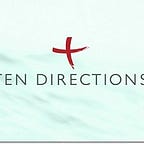Finding Ground
By Cléo Burke
“Ground is the place to go when overwhelmed with thoughts and fears. It can hold our confusion with unwavering presence. We can source the earth’s formidable strength to connect with how these qualities live inside of us. In her timeless gaze, we open to the present; we slow down.”
Kelsey Blackwell, Your Body is Your Guru
I’ve been thinking about grounding a lot over these few weeks, and sensing into the ways I am experiencing more or less ground at any given moment. Together we are in a collective disruption. Most of us have not encountered such a phenomenon in our lifetimes. For this, there is no road map, no certainty.
We are needing to find new ways to be together while also making sense of being apart. The level of intensity is variable, depending on the role each of us is holding, on the context of who we live with, of where we live, on how resourced we each are at any given moment, on our own health and well-being, on our networks, etc. Not only are we each trying to figure out how to manage our own selves, our own feelings and ways of being in this strange time, but how to be in relationship to one another and what it means to be part of something bigger.
In this uncertainty, when stress and possibly worry, grief, anger inevitably increase, it can be helpful to have some ways of bringing ourselves into the present moment. This is often referred to as ‘grounding’ or centering.
One way to think about grounding is by paying attention to your exterior. Your exterior refers to anything that is outside of yourself. So if you are feeling stressed, overwhelmed or anxious, one way to return to the present is to attend to what is immediately around you. For example, you might try:
- Looking around whatever room you are in in your house and find anything that is the colour green, or anything that is square in shape. You might even try saying it out loud to bring in your hearing sense.
- Having a clock that ticks nearby, and setting a reminder on your phone every so often to pause and listen for the sound.
- Sitting with your back against a tree, maybe even giving it a hug!
Another option for grounding is to pay attention to your interior. When bringing attention inwardly to your body, there are some things to first consider:
- Go slow: Sometimes when your body feels activated, it can become more overwhelming to pay attention to it. Slow, small doses can be helpful.
- Listen deeply: Know that your body is wise and true, AND you are in relationship so it’s okay to take your time with one another.
- Choice is always available: You can stay with attending to your body or stop at any time. There is no right or wrong way to be. And you can change your mind as much as you like.
- Liberal inward compassion: Now is the time to dial this WAY UP. Being disrupted is real, and it’s happening. Making room for that is more important than ever. AND being kind to yourself in it is essential.
Here’s one exercise that I often use for getting grounded. I’m calling it the coffee press for simplicity sake. Use it in a way that makes sense for you. Know that it is one that you can pull out anytime. I often use this with groups, and generally find it very centring. You can do this for 1 minute or as long as needed.
PS — I cannot remember where I learned this years ago. If it is familiar to you, and you have some ideas, I would love to give credit to the person or tradition that it comes from.
Be gentle in this time — physically distant, yet socially/emotionally connected.
Warm regards,
Cléo
Cléo Burke is a Certified Integral Facilitator, Licensed Counselling Therapist and Associate Integral Coach. She brings over 20 years experience from within the fields of outdoor recreation, education and healthcare to her offerings in transformational and experiential learning. As a facilitator, educator, therapist and coach, she designs and delivers well-balanced and engaging programs centred around elevating personal and collective development. She emphasizes incorporating embodied awareness and somatic practices as a means to building capacity and skill for everything from working with complexity to uncovering particular dynamics and patterns to cultivating authentic leadership. She hails from K’jipuktuk/Halifax, Nova Scotia on the east coast of Canada.
